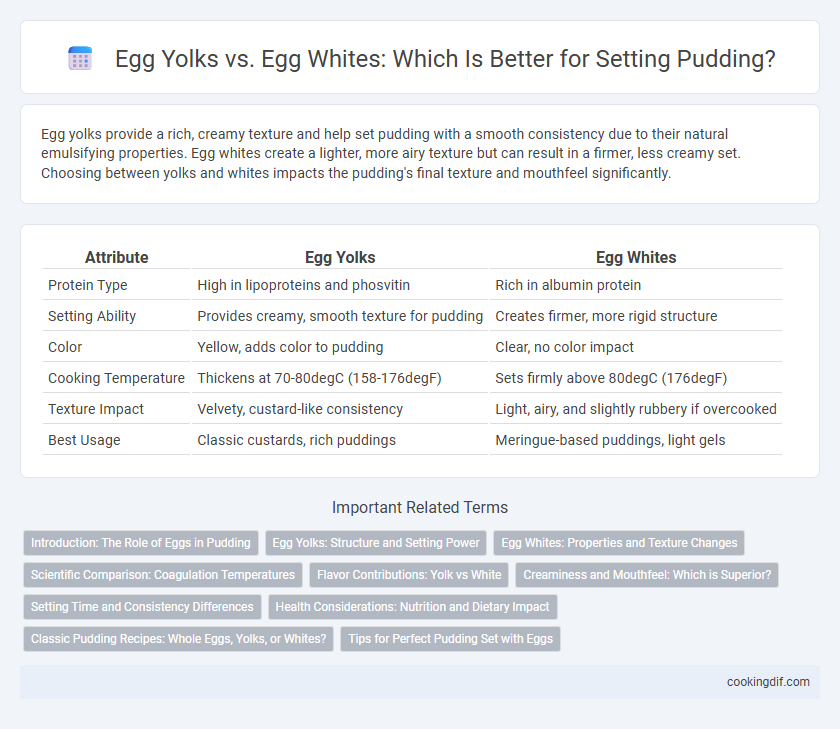Egg yolks provide a rich, creamy texture and help set pudding with a smooth consistency due to their natural emulsifying properties. Egg whites create a lighter, more airy texture but can result in a firmer, less creamy set. Choosing between yolks and whites impacts the pudding's final texture and mouthfeel significantly.
Table of Comparison
| Attribute | Egg Yolks | Egg Whites |
|---|---|---|
| Protein Type | High in lipoproteins and phosvitin | Rich in albumin protein |
| Setting Ability | Provides creamy, smooth texture for pudding | Creates firmer, more rigid structure |
| Color | Yellow, adds color to pudding | Clear, no color impact |
| Cooking Temperature | Thickens at 70-80degC (158-176degF) | Sets firmly above 80degC (176degF) |
| Texture Impact | Velvety, custard-like consistency | Light, airy, and slightly rubbery if overcooked |
| Best Usage | Classic custards, rich puddings | Meringue-based puddings, light gels |
Introduction: The Role of Eggs in Pudding
Egg yolks play a crucial role in pudding by providing rich fats and proteins that contribute to a creamy texture and smooth consistency, essential for proper setting. Egg whites, primarily composed of albumin proteins, offer structure through coagulation and can create a lighter, more aerated pudding when whipped. The balance between yolk and white determines the final pudding's firmness and mouthfeel, with yolks favoring creaminess and whites enhancing stability and lightness.
Egg Yolks: Structure and Setting Power
Egg yolks contain lecithin and proteins that provide strong emulsifying properties and rich structure, crucial for setting puddings with a creamy texture. Their higher fat content contributes to a smooth, stable custard that thickens effectively upon gentle heat. Unlike egg whites, which create a firmer but lighter set, yolks yield a denser, silkier consistency ideal for traditional pudding recipes.
Egg Whites: Properties and Texture Changes
Egg whites are composed primarily of water and proteins such as albumin, which coagulate when heated, providing a firm and airy structure essential for setting puddings. Their ability to trap air during whipping creates a light, fluffy texture that contrasts with the denser consistency achieved by egg yolks. The protein denaturation in egg whites begins around 140degF (60degC), solidifying the pudding while enhancing its volume and stability without adding richness or fat.
Scientific Comparison: Coagulation Temperatures
Egg yolks coagulate at higher temperatures, typically between 65degC and 70degC, providing a creamy and rich texture to pudding. Egg whites begin to coagulate at a lower temperature, around 60degC to 65degC, resulting in a firmer and more gelatinous set. This difference in coagulation temperatures influences the final consistency, with yolks contributing smoothness and whites creating structure in the pudding.
Flavor Contributions: Yolk vs White
Egg yolks contribute a rich, creamy texture and a slightly sweet, custard-like flavor that enhances the overall depth of pudding. Egg whites provide a lighter, more neutral taste, focusing primarily on structure without altering the flavor profile significantly. Utilizing yolks intensifies the pudding's creaminess, while whites prioritize firmness and a cleaner, less fatty mouthfeel.
Creaminess and Mouthfeel: Which is Superior?
Egg yolks provide superior creaminess and a rich mouthfeel in puddings due to their high fat content and emulsifying properties, which create a smooth, velvety texture. Egg whites, composed primarily of protein, contribute to firmness and structure but result in a lighter, less creamy consistency. For a pudding that prioritizes indulgent creaminess and a luxurious mouthfeel, egg yolks are the preferred choice over egg whites.
Setting Time and Consistency Differences
Egg yolks provide a richer, creamier pudding texture and typically require a longer setting time due to their higher fat content and emulsifying properties. Egg whites create a lighter, firmer consistency and set more quickly because of their high protein concentration that coagulates rapidly when heated. Choosing between egg yolks and egg whites significantly impacts the pudding's final texture and cooking duration.
Health Considerations: Nutrition and Dietary Impact
Egg yolks contain rich nutrients like vitamins A, D, E, and healthy fats that help in creating a smooth, creamy pudding texture but add more calories and cholesterol. Egg whites provide a lower-calorie, high-protein option that contributes to a firmer, lighter set without the fat content, making them suitable for low-fat or heart-healthy diets. Choosing between yolks and whites affects pudding's nutritional profile, with yolks enhancing richness and nutritional density, while whites promote a leaner, less calorie-dense dessert.
Classic Pudding Recipes: Whole Eggs, Yolks, or Whites?
Classic pudding recipes often rely on egg yolks for their rich texture and creamy consistency, as yolks provide essential fats and emulsifiers that help thicken the mixture without curdling. Egg whites contribute to a lighter, more aerated structure, ideal for mousse-like or chiffon-style puddings but lack the fat needed for smooth, custard-style set. Whole eggs strike a balance by combining the thickening power of proteins in whites with the richness of yolks, making them suitable for versatile pudding recipes that require moderate firmness and silky mouthfeel.
Tips for Perfect Pudding Set with Eggs
Egg yolks are ideal for achieving a rich, creamy pudding with a smooth, custard-like texture due to their high fat and protein content, which helps thicken and set the mixture evenly. Egg whites provide a lighter, fluffier texture but require careful whipping and folding to avoid a grainy or watery pudding. For the perfect pudding set, gently temper egg yolks before incorporation to prevent curdling, and cook the mixture slowly over low heat until it thickens just enough to coat the back of a spoon.
Egg yolks vs Egg whites for setting Infographic

 cookingdif.com
cookingdif.com